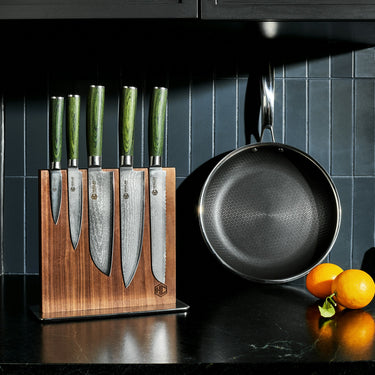A Guide To Using HexClad Knives
by HexClad Cookware

HexClad’s Damascus steel-forged knives are a beautiful addition to any kitchen. You’d be forgiven for displaying your kitchen knife set on your magnetic knife block as a piece of art. They’re good for more than just decoration, naturally. The wide variety of HexClad knives will have you chopping, dicing, fileting, and carving everything in sight.
It’s key to use the correct knife for the right task. Using a cleaver to debone a chicken would be difficult and even dangerous. There’s also the question of efficiency. Though a chef’s knife can work to hull strawberries, the short blade and fine tip of a paring knife will be easier to maneuver. Read on for tips on how to use each of your kitchen knives.
Once you’ve invested in high-quality knives, you’re going to want to keep them in good condition. Check out our guide to caring for your knives to maintain their sharp edges and rust-free blades.
Here’s how to use the range of HexClad’s kitchen knives:
Chef’s Knife
Think of the chef’s knife as your kitchen workhorse, the knife you could take on vacation and make it through every task. A chef’s knife has a long, tapered blade that’s generally around 8-inches long. Use it for slicing, chopping, mincing, and dicing everything from vegetables to herbs to slicing meat. The tapered tip of the knife is great for more delicate tasks like scoring a fish or removing the stems from tomatoes, strawberries, and other fruit. Because you’re likely to reach for this knife above all others, it’s wise to use a honing steel before each use.
Serrated Knife
Also referred to as a bread knife, the serrated knife has saw-like teeth that can slice through tender cakes without tearing and the toughest sourdough crust with ease. Because the saw-like edge gets a good grip on whatever it cuts, a serrated knife can be a good pick for thick-skinned fruits and vegetables like watermelon, butternut squash, or pumpkin. Anytime you want to puncture skin without squishing the interior—think: the ripest peak-summer tomato—you should grab your serrated knife.
Utility Knife
Like the name suggests, a utility knife is a jack-of-all-trades. It’s great for slicing fruits, cooked meats, vegetables, and soft bread. Though a utility knife is great for peeling potatoes and other thin-skinned vegetables (if you prefer it to a peeler), you should avoid using a utility knife for harder vegetables or heavy-duty prep.
Paring Knife
Clocking it at around 3.5-inches long, the blade of a paring knife is mightier than it looks. Use it for peeling, deseeding, coring, and trimming or for quick, off-the-cuff tasks, like slicing a single hard-cooked egg. When you want a blade you can easily maneuver or to do detailed precision work, then choose the paring knife. Use a paring knife to hull strawberries, devein shrimp, or segment citrus.
Cleaver
The hefty rectangular blade of a heavy-duty cleaver is ideal for hacking through thick cuts of meat and making quick work of hearty vegetables like winter squash or peak-summer watermelon. A cleaver is strong enough to slice through bones and thick cuts of meat, which is why it’s the preferred tool of butchers and often called a butcher knife.
Nakiri Knife
Though it resembles a cleaver in shape, a nakiri knife is best for vegetable prep, which is the traditional use of this Japanese-style knife. The nakiri’s straight blade makes it good for an up-and-down motion rather than the rocking movement of a chef’s knife. Use it to chop carrots, turn onions into paper thin shreds, or to slice eggplant into even rounds. Because it has a thin blade, nakiri knives are better for delicate work. Opt for a cleaver if you want to cut through thick veggies or butcher meat.
Santoku Knife
A santoku knife is up to the task of being your everyday knife thanks to its comfort with slicing, dicing, and chopping. Many cooks prefer a santoku for its slightly more compact blade that favors a downward motion rather than the rocking motion of the chef’s knife. The blade of a santoku knife ranges from 6- to 7-inches long with a relatively lightweight blade. Use it for your everyday vegetable prep, to fillet a fish, or to slice meat.
Boning and Filet Knife
As the name implies, a boning knife is great for deboning, but you can use it for a wide variety of tasks for meat, fish, and poultry. The slightly flexible blade makes it great for fileting fish, hence the knife’s dual name, but it’s sturdy enough to use to break down a chicken. The curve of the knife allows it to slip into hard-to-reach places in meat or fish without making large incisions. Meanwhile, the small, sharp tip can be used for strategic tasks like reaching joints and connective tissues.
Carving Knife
Sure, you can hack away at the Thanksgiving turkey or Sunday roast with any old knife, but with a carving knife, it will be easy and stylish. This knife is long, thin, and—as in the case of HexClad’s knife—often has a curved end (which technically makes it a slicing knife), which prevents stabbing the meat. Use it to shave perfect slices of a roast chicken, to make perfect sandwich-worthy slices of roast beef, and to carve a baked ham for a celebratory platter.